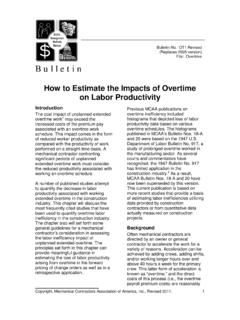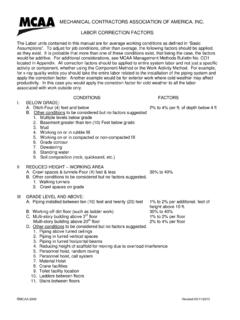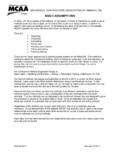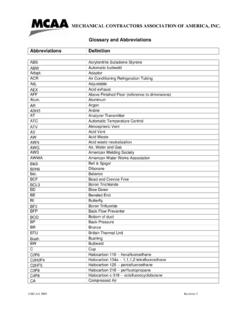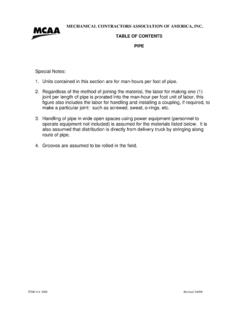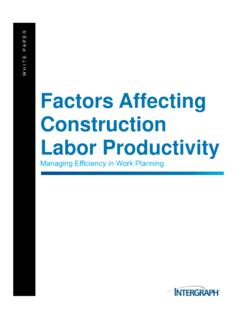Transcription of MCAA Management Methods Manual - WebLEM
1 B u l l e t i n Copyright, Mechanical Contractors Association of America, Inc., Revised 2011. 1 Bulletin No. PD2 Revised (Replaces 2005 version) File: Productivity Factors Affecting Labor Productivity Instructions on the use of MCAA s Labor Factors are provided in the section of this bulletin titled How to Use the MCAA Labor Factors. Note: The MCAA has replaced the user information in Bulletin No. 58 with updated information in Bulletin PD2 and also in its publication entitled Change Orders, Productivity, Overtime A Primer for the Construction Industry, 2014 edition.
2 Bulletin No. 58 was formally withdrawn from publication in 2005 and the user is referred to the above-referenced document for instructions as to the proper application of the MCAA labor inefficiency factors. Copyright, Mechanical Contractors Association of America, Inc., Revised 2011. 2 Copyright, Mechanical Contractors Association of America, Inc., Revised 2011. 3 Connecting the Cause and Effect in Loss of Productivity Claims By Gerson B. Kramer Gerson B. Kramer began acquiring his vast experience in measuring differential productivity during his first post-college job at the Department of Labor s Bureau of Labor Statistics.
3 After graduating from George Washington University School of Law, Mr. Kramer joined the Justice Department s Court of Claims Section and later the Commerce Department s Appeals Board. For ten years prior to his retirement, Mr. Kramer served as chairman and chief administrative judge of the Department of Transportation s Contract Appeals Board. In that capacity, Mr. Kramer heard cases involving contractors claims for loss of labor productivity and authored a reported decision on one of the government s largest inefficiency cases in the history of any major board of contract appeals.
4 The construction industry is one of the leading capital industries that drive the economy. As an industry, it depends to a great extent upon labor productivity to remain profitable. Yet, many construction firms do not maintain the necessary records to supply the quantification of its labor productivity. A contractor needs to maintain accurate contemporaneous productivity records to manage its labor forces and to serve as a foundation in the event of a productivity claim. While the courts and boards have established the principle that a contractor need not compute its loss of productivity with exactness, it would appear that accurate recording of a contractor s productivity is simply a Management necessity to ensure profitability, irrespective of the portent of an inefficiency claim.
5 One of the fundamental issues that a trier of fact considers in hearing a contractor s inefficiency claim is cause and effect. Important in the consideration is the question of whether or not the contractor s claims as to productivity impacts comport with the quantum being sought. In my experience, productivity can be summed up as the efficiency that contractors achieve in converting inputs to outputs. In the construction industry, this usually means the conversion of labor hours to a quantity of installed materials, such as tons of steel erected, cubic yards of concrete poured or linear feet of pipe installed.
6 However, where productivity is concerned, there is no general agreement and no black letter law as to how this is to be quantified. This is equally true of quantifying the loss of productivity. Furthermore, standard cost accounting categories and standard monetary categories do not readily yield the necessary quantifications of labor productivity or loss of productivity. Neither the IRS nor the vast majority of construction CFOs arrange for, or demand, the reporting of the necessary elements to calculate or quantify productivity or its loss.
7 This lack of quantification on productivity or its loss becomes problematical when disputes arise. The disputes process that is presented to tribunals calls for magistrates to make findings of fact on Copyright, Mechanical Contractors Association of America, Inc., Revised 2011. 4 very specific matters. Although there is currently no accepted empirical study that delineates a specific methodology or a particular means of record keeping to prove productivity or the loss of productivity, one method of labor productivity quantification that has achieved a relatively high level of acceptance is known as the measured mile analysis.
8 This methodology is highly dependent upon the contractor s books and records and also upon the presence of an unimpacted and impacted area or period by which a production ratio can be computed. While this methodology has been well received by the courts and boards, it is also true that this methodology cannot be applied on many construction projects for a host of reasons, two being the lack of detailed productivity record keeping and the lack of suitable or comparable unimpacted areas or time frames. The inability to prepare a measured mile analysis does not, in and of itself, bar a contractor s loss of productivity claim.
9 In such cases, the contractor must apply a different methodology to connect the cause and effect. It is a fact that the MCAA factors have been in use for over 30 years in furnishing a means of estimating loss of productivity in construction matters. One of the most beneficial and advantageous facts is that the MCAA factors require users to consider carefully the narrative facts and project events or milestones with the trends shown by the numbers. How to Use the MCAA Labor Factors repeatedly instructs users to assess carefully each and every element of fact along with the use of the percentage factors provided by Factors Affecting Labor Productivity.
10 Direct and indirect impacts need to be quantified carefully in conjunction with the specific events of the project. This process of matching the facts with the claimed loss of productivity is designed to provide the deciding tribunals with a degree of confidence necessary to reach the ultimate decisions. It is well recognized that a contractor does not have to prove its loss of productivity with mathematical exactitude; however this does not relieve the contractor from making a compelling case as to the specific causes of the impacts and to connect then with a logical effect.
